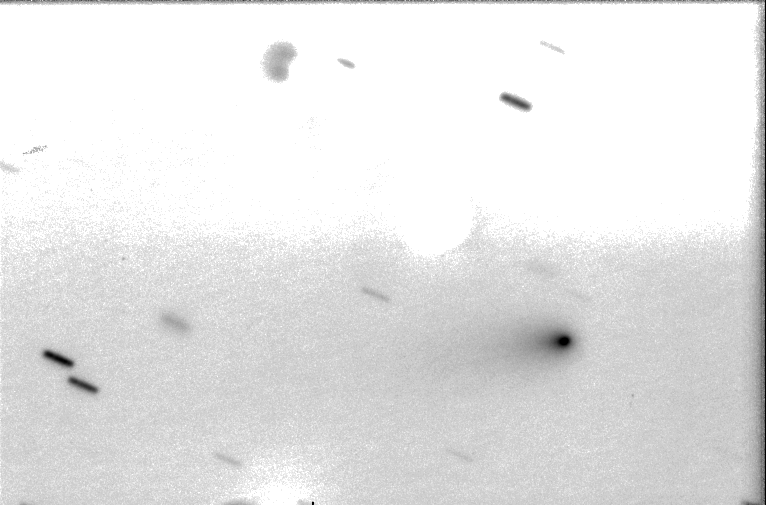
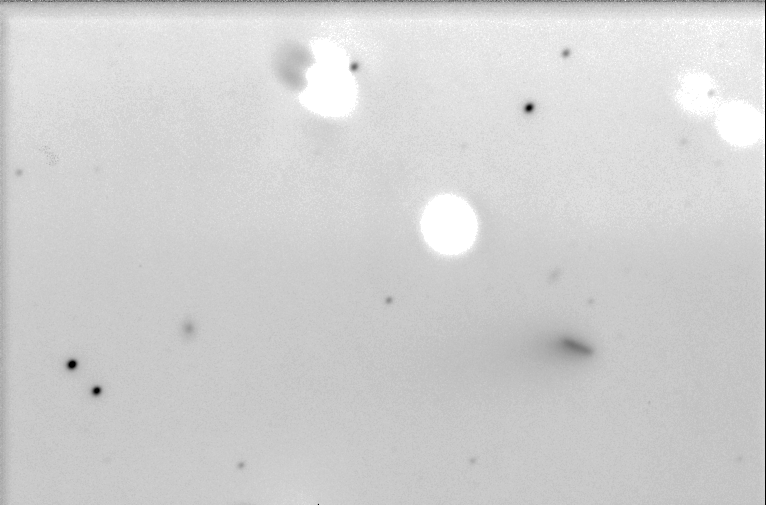
| Description:Here the comet can clearly be seen in negative colours.
In the top image, the comet's motion is discernable against the background stars, which come out as
streaks and a dust tail to the left.
The bottom image is processed tracking the stars instead of the comet. The 16th
magnitude galaxy KUG 1354+131 (a.k.a. LEDA 49625) can be seen to the
left of the comet. The white dots and associated grey blob are due to
flatfielding errors caused by moving dust grains on the CCD camera window.
Image information: Stacked, dark-subtracted, registered combination of
112 x 10s white-light images. The image is in negative. Image taken 01/03/2006
00:06-00:29.
Physical information: Magnitude: roughly 14.6
+/- 0.4 (no appropriate field stars were available for a good calibration),
tail: ~2.5' @ PA 245.5, dist. from Earth: 0.7714AU, dist. from Sun: 1.6177AU,
magnitude comparable to expectation.
|
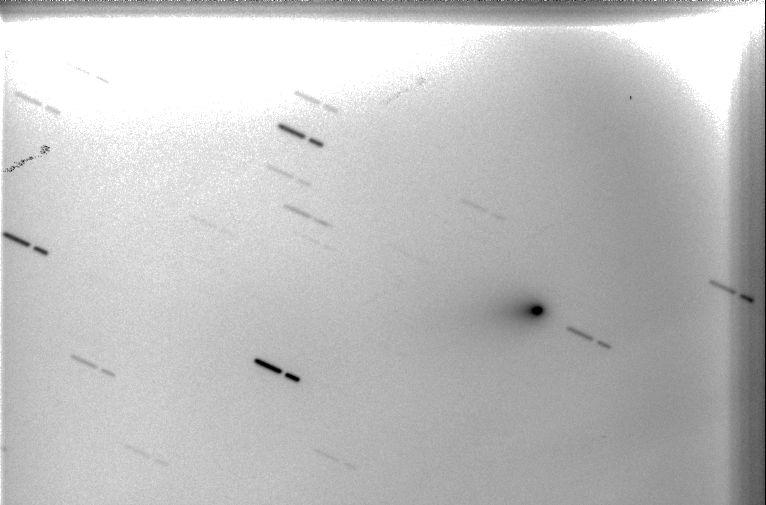
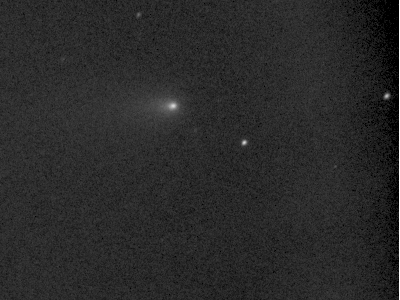
| Description: Re-imaged on 02/03/06, the comet appears to be
roughly 20-30% brighter. The tail appears to be weaker and is only visible much
closer to the comet. The animation shows the track of the comet over this time.
Image information: Stacked, dark-subtracted, registered combination of
200 x 10s white-light images. The image is in negative. Image taken 02/03/06
23:15-00:10 (3rd). Animation shows 10 stacked frames at a time.
Physical information: Magnitude: roughly 14.4
+/- 0.5 (no appropriate field stars were available for a good calibration),
tail: ~1.7' @ PA ~260, coma ~17", dist. from Earth: 0.7431AU, dist. from Sun:
1.5989AU, magnitude comparable to expectation.
|
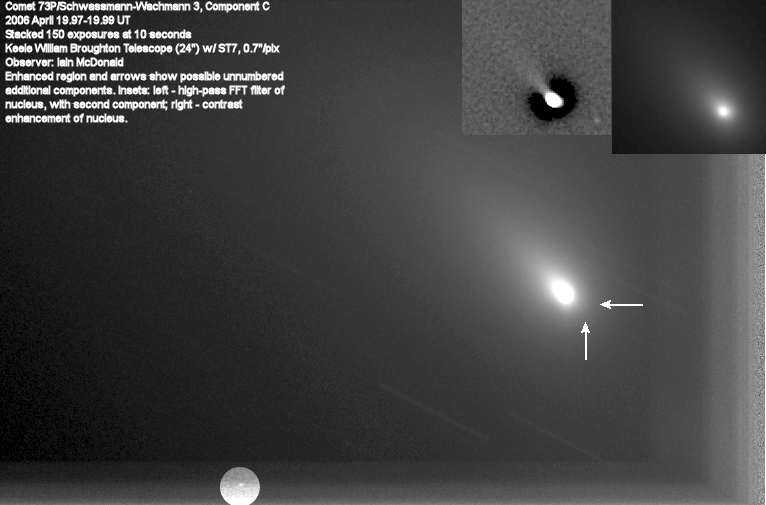
| Description: Imaged again on 19/04/06, the comet is significantly
brighter. The tail has notably changed direction and is visible to the
upper-left of the comet (north is down). Two objects that appear to be real
and track with the comet are highlighted on this image, and may represent
unnumbered components that have broken off the main body of the comet. The
brightness of the brightest of these is probably around magnitude 16.
Image information: Stacked, dark-subtracted, flatfielded, registered
combination of 150 x 10s white-light images. Image taken 19/04/06 23:11-23:44
(UT). Inset processing and annotation in AIP4Win and PaintShopPro 9.
Physical information: Magnitude: roughly 7.4, dist. from Earth:
0.2114AU, dist. from Sun: 1.1643AU.
|
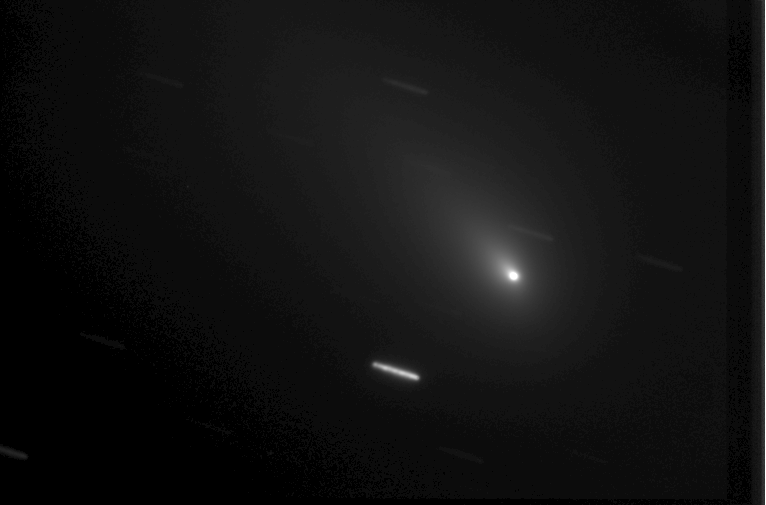
| Description: Imaged again on 27/04/06, the comet is again significantly
brighter. The dust tail continues to move around towards the south (top of
frame). Although the other components are showing signs of breaking up, C (the
main component) appears to be remaining intact.
Image information: Stacked, dark-subtracted, flatfielded, registered
combination of 30 x 10s white-light images. Image taken 27/04/06 23:39
(UT).
Physical information: Magnitude: ephemerides estimates vary between
6.2 and 9.4, dist. from Earth: 0.1472AU, dist. from Sun: 1.1025AU.
|

| Description: Another image on 01/05/06, 10.4 days before closest
approach to Earth (perigee). The dust tail is still clearly visible and appears
roughly colourless. There appears to have been
some horizontal smearing caused by a combination of telescope tracking errors
and the comet's actual motion across the sky (7"/min).
Image information: Stacked, dark-subtracted, flatfielded, registered
combination of 40 x 10s white-light images and 12 x 10s images in I R V and B
bands. Image taken 01/05/06 23:32-23:56 (UT).
Physical information: Magnitude: approx. 5.6 (confirmed visual at dark
site), dist. from Earth: 0.1193AU (17.8Mkm), dist. from Sun: 1.074AU.
|
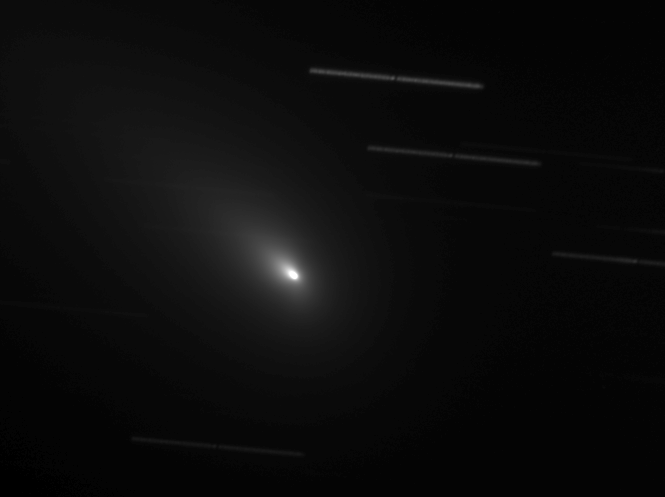
| Description: Another image of component C, taken 8.4 days before
perigee. The comet was moving at a very fast 8.5"/min, meaning that even in a
10 second exposure, it has drifted by two pixels, making getting a well-focussed
image difficult.
Image information: Stacked, dark-subtracted, flatfielded, registered
combination of 60 x 10s white-light images. Image taken 03/05/06 23:55
(UT).
Physical information: Magnitude: approx. 5-6 (confirmed naked eye, May
1st), dist. from Earth: 0.1069AU (16.0Mkm), dist. from Sun: 1.0611AU.
|
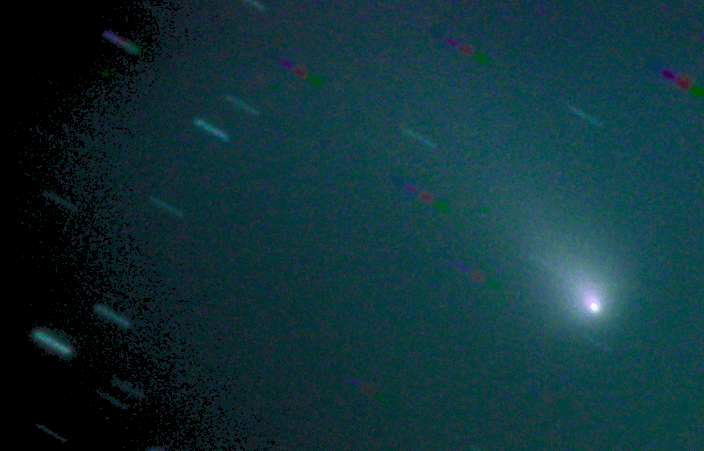
| Description: Our first image of component B, which had experienced a
split only a few nights before. It appears very much like component C, except
with a slightly more diffuse tail around the nucleus. It is probably about the
same size as C.
Image information: Stacked, dark-subtracted, flatfielded, registered
combination of 30 x 10s white-light images and 10 x 10s images in I R V and B
bands. Images taken 27/04/06 22:54-23:30 (UT).
Physical information: Magnitude: ephemerides estimates vary between
8.2 and 9.3, dist. from Earth: 0.153AU (22.9Mkm), dist. from Sun: 1.110AU,
scale: 111km/pixel.
|
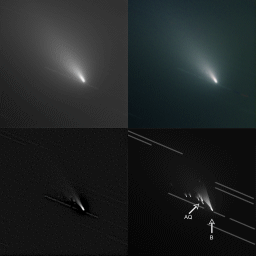
| Description: A second image, taken 13.1 days before perigee,
illustrating the
breakup of the comet. The largest runaway piece has been labelled as
fragment AQ. The others are undesignated. The bottom-left image has been altered
to seperate the fragments more clearly from the tail. The fragments have been
shown in diagramatical form on the bottom-right for easy identification.
Image information: See image. Images taken 01/05/06 23:11 - 02/05/06
00:54 (UT).
Physical information: Magnitude: approx. 7.6 (AQ approx. 11), dist.
from Earth: 0.123AU (18.4Mkm), dist. from Sun: 1.081AU, scale: 89km/pixel.
|
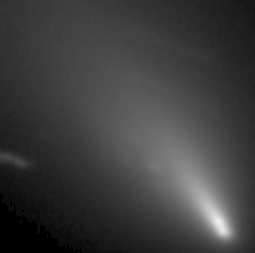
| Description: The same data that was used to produce the above image
was reprocessed and magnified to confirm reports that the nucleus had split into
two components. The brighter, trailing component moves about 0.8 pixels upwards
in relation to the fainter, leading component. Component AQ is also visible,
trailing B by about 2900km.
Image information: Stacked, dark-subtracted, flatfielded,
registered combination of 40 x 20s / 30 x 10s and 4 x 20 x 15s white-light images.
Enlargement: 2x. Images taken 01/05/06 23:11 - 02/05/06 00:54 (UT).
Physical information: As above.
|
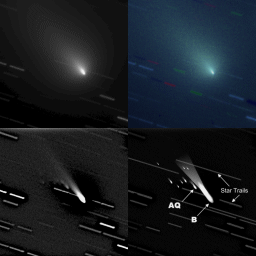
| Description: A third image, taken 11.1 days before perigee,
further illustrating the
breakup of the comet, similar to the above images taken two days previously.
Fragment AQ can be seen moving away from fragment B. This is partly real motion
and partly due to the fact that the objects are still approaching us. The
fragments appear to be moving apart at roughly 8.8 km/hour (5.5 mi/h).
Image information: See image. Images taken
03/05/06 23:12 - 04/05/06 01:27 (UT).
Physical information: Magnitude: approx. 7-8 (AQ approx. 9-11), dist.
from Earth: 0.109AU (16.3Mkm), dist. from Sun: 1.068AU, scale: 79km/pixel.
|

| Description: In this image, taken 4.25 days before perigee, the comet
has undergone a dramatic change and brightening. Even with the gibbous moon that
night, it was a naked eye object for many observers (not in Keele - Newcastle
puts out too much light pollution). The comet appears to have developed jets
with possible fine structure. Component AQ appears to either have disintegrated
or evaporated, as it is not where we expected it to be.
Image information: See image. Images taken 10/05/06 00:23 - 00:52 (UT).
Physical information: Magnitude: approx. 4-5, dist.
from Earth: 0.076AU (11.4Mkm), dist. from Sun: 1.030AU, scale: 55km/pixel.
|
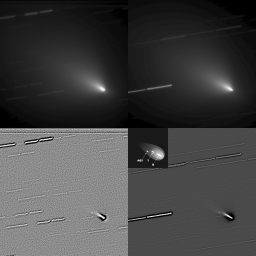
| Description: Two images here, taken 3.37 and 3.21 days before
perigee, respectively, shows the short timescale of the evolution of the comet,
which at the time was fading from outburst. In the left image (although more out
of focus) the nucleus appears more round. In the right-hand image, once
processing has ben done to remove the glow of the dust in the comet's coma, two
fragments can be seen near the nucleus. It is possible one of these is AQ.
Image information: See image. Images taken 10/05/06 21:11 - 22:50,
11/05/06 00:56 - 01:14 (UT).
Physical information: Magnitude: approx. 4-5 (nuclear magnitude
measured at ~10 within 15"); dist. from Earth: 0.0728-0.0722AU (10.86-10.80Mkm), dist.
from Sun: 1.0247-1.0238AU, scale: 52.7-52.2km/pixel.
|
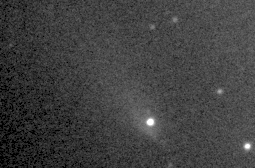
| Description: Here we see component G shortly after a
catastrophic
breakup. Note that this image tracks the stars, since the comet is too faint
to track with our software. The comet is visible as the "smudge with a tail"
near the brightest star and appears to have pretty much disintegrated.
Image information: Stacked, dark-subtracted, flatfielded, registered
combination of 24 x 10s white-light images. Image taken 27/04/06 22:50 (UT).
Physical information: Magnitude: unknown, probably about 11, dist.
from Earth: 0.154AU, dist. from Sun: 1.111AU.
|

| Description: This image shows the dying rubble of fragment G after
its
apparently total
breakup. The processing software we used has managed to track the comet, but
inaccurately. As a result, the comet will be slightly out of focus and will also
be trailed by about 4 pixels.
Image information: Stacked, dark-subtracted, flatfielded, registered
combination of 20 x 20s white-light images, with median filter to remove noise.
Image taken 03/05/06 23:07 (UT).
Physical information: Magnitude: estimated (inaccurately) at 15.7 +/- 2.0, dist.
from Earth: 0.110AU (16.5Mkm), dist. from Sun: 1.069AU.
|
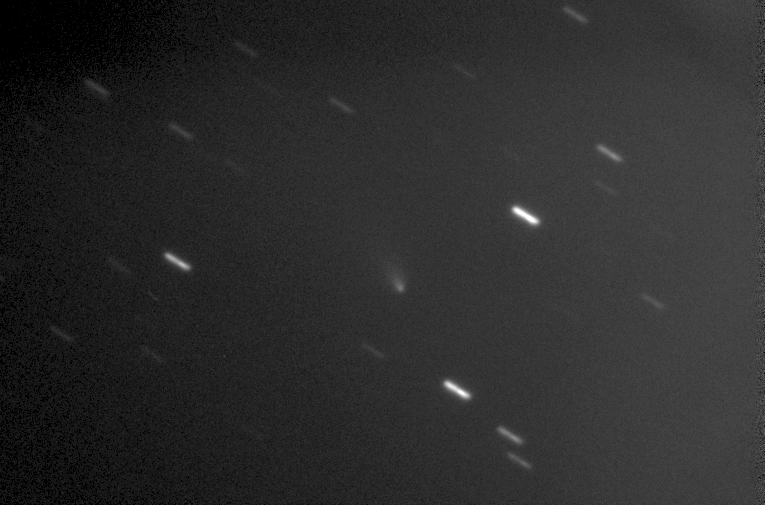
| Description: Imaged while in outburst, this component of the comet is
smaller than B, C and G, but has remained relatively intact. It's small coma
size and dust tail ar clearly visible here.
Image information: Stacked, dark-subtracted, flatfielded, registered
combination of 24 x 10s white-light images. Images taken 27/04/06 22:30 (UT).
Physical information: Magnitude: brighter than mag. 15, dist. from
Earth: 0.155AU, dist. from Sun: 1.112AU.
|
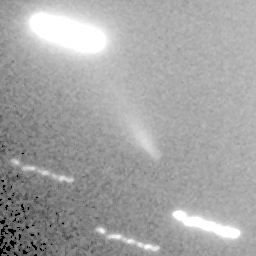
| Description: Component R was reported to still be in outburst near
this time. The image isn't tracked very well here due to the faintness of the
comet, and long exposures means that the nucleus has trailed a few pixels,
resulting in a slightly blurred image.
Image information: Stacked, dark-subtracted, flatfielded, registered
combination of 20 x 20s white-light images, with median filter to remove noise.
Image taken 03/05/06 22:55 (UT).
Physical information: Magnitude: estimated about 13 +/- 2, dist.
from Earth: 0.111AU (16.6Mkm), dist. from Sun: 1.070AU.
|

















